Looking for a comforting meal that’s packed with flavor, easy to prepare, and entirely plant-based? Eggplant Chickpea Tagine with Couscous is a Moroccan-inspired stew that combines tender, caramelized eggplant, hearty chickpeas, and a rich blend of spices like cumin, cinnamon, and Ras El Hanout. Served over fluffy, cinnamon-scented couscous, this dish is not only vegan and gluten-free but also deeply satisfying and nourishing.
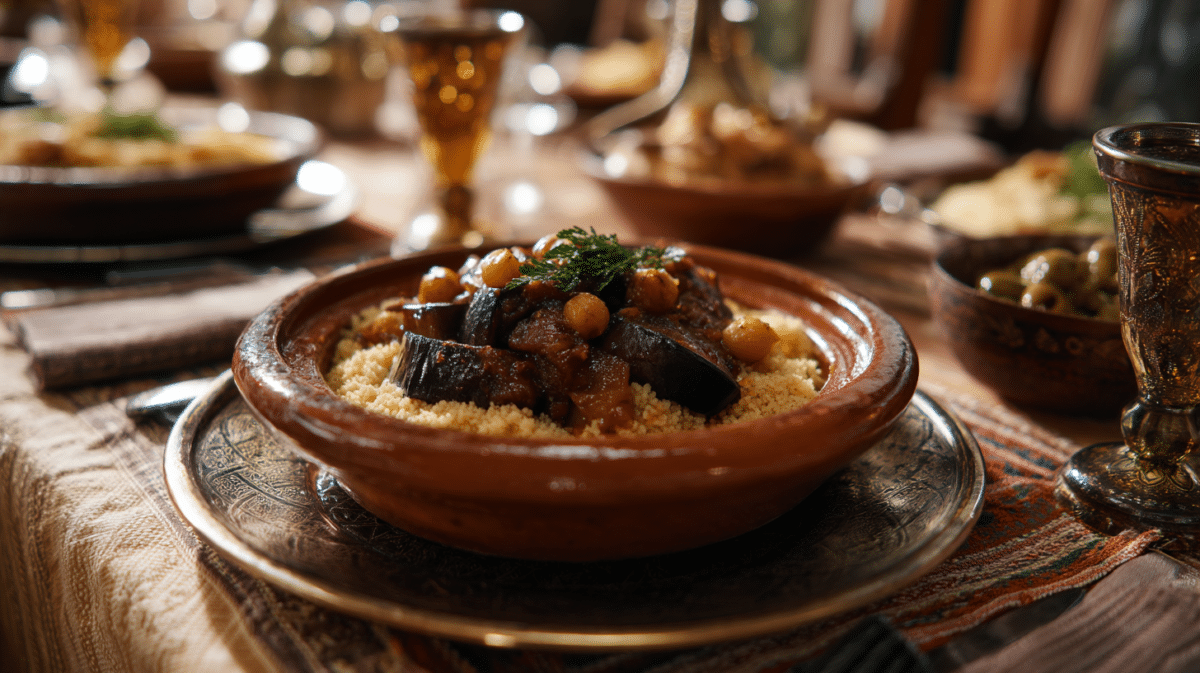
Whether you’re exploring global cuisines or simply want to switch up your weeknight dinners, this recipe offers a delicious introduction to Moroccan cooking techniques and ingredients.
Learn more about Tunisian couscous and its flavorful variations.
PART 1: Introduction to Eggplant Chickpea Tagine
What Makes Tagine Recipes So Special?
A tagine is more than just a stew—it’s a traditional North African cooking method that transforms everyday ingredients into something extraordinary. The dish gets its name from the conical clay pot used to cook it, which traps steam and redistributes moisture during slow cooking. This technique allows spices to fully bloom and ingredients to become irresistibly tender and flavorful.
Don’t worry if you don’t own a tagine. A heavy-lidded pot or Dutch oven works just as well, giving you the same depth of flavor.
Tagine recipes often balance savory, sweet, and spiced notes. In this version, you’ll taste warm Moroccan spices, rich tomato sauce, and subtle sweetness from raisins or apricots—all perfectly absorbed by the eggplant and chickpeas.
A Brief History of Moroccan Tagine Cuisine
The origins of tagine cooking trace back to the Berber people of North Africa. These nomadic crews developed the clay pot to create slow-cooked, one-pot meals in desert environments. Over centuries, Moroccan tagines evolved to incorporate Arab, Mediterranean, and Andalusian influences, giving rise to a cuisine known for its complex spices and balanced flavors.
Today, dishes like this Eggplant Chickpea Tagine with Couscous carry on that tradition in a plant-based way. They highlight seasonal vegetables, legumes, and global flavors with every bite.
Check out this authentic Moroccan Chicken Tagine Recipe for a protein-rich variation rooted in tradition.
PART 2: Understanding the Ingredients
Why Eggplant is the Perfect Meat Alternative
Eggplant is a staple in Mediterranean and North African cuisine, thanks to its hearty texture and sponge-like ability to absorb flavor. When properly prepared—salted, seared, and slow-cooked—eggplant develops a succulent, almost meaty consistency. It becomes the perfect base for a vegan tagine, especially when paired with bold spices and a tomato-rich sauce.
In this dish, eggplant not only adds body but also helps carry the flavors of garlic, spices, and herbs throughout the stew.
The Role of Chickpeas in North African Stews
Chickpeas bring nutritional power and texture to this dish. They’re high in protein, fiber, and essential minerals—making them a smart swap for meat in plant-based recipes. In tagines, chickpeas soak up the aromatic broth while adding a slight nutty flavor and firmness that contrasts beautifully with the soft eggplant.
Wondering how chickpeas can be adapted into more meals? Don’t miss our recipe for Chickpea Shawarma Wrap with Garlic Sauce—another great way to enjoy their versatile flavor.
Couscous: A Traditional Pairing for Tagine
Couscous may look like a grain, but it’s actually a tiny pasta made from semolina flour. Light and fluffy when steamed, couscous is the ideal vehicle to soak up rich tagine sauces. For this recipe, we infuse the couscous with cinnamon and cumin to complement the stew’s warm flavors.
Don’t miss our tutorial on Tunisian Couscous with Lamb to explore more ways this North African staple is served.
For a lighter side pairing, explore this vibrant Mediterranean Crunch Salad that brings freshness to the plate.
PART 3: Eggplant Preparation for Tagine Recipes
How to Properly Salt and Soak Eggplant
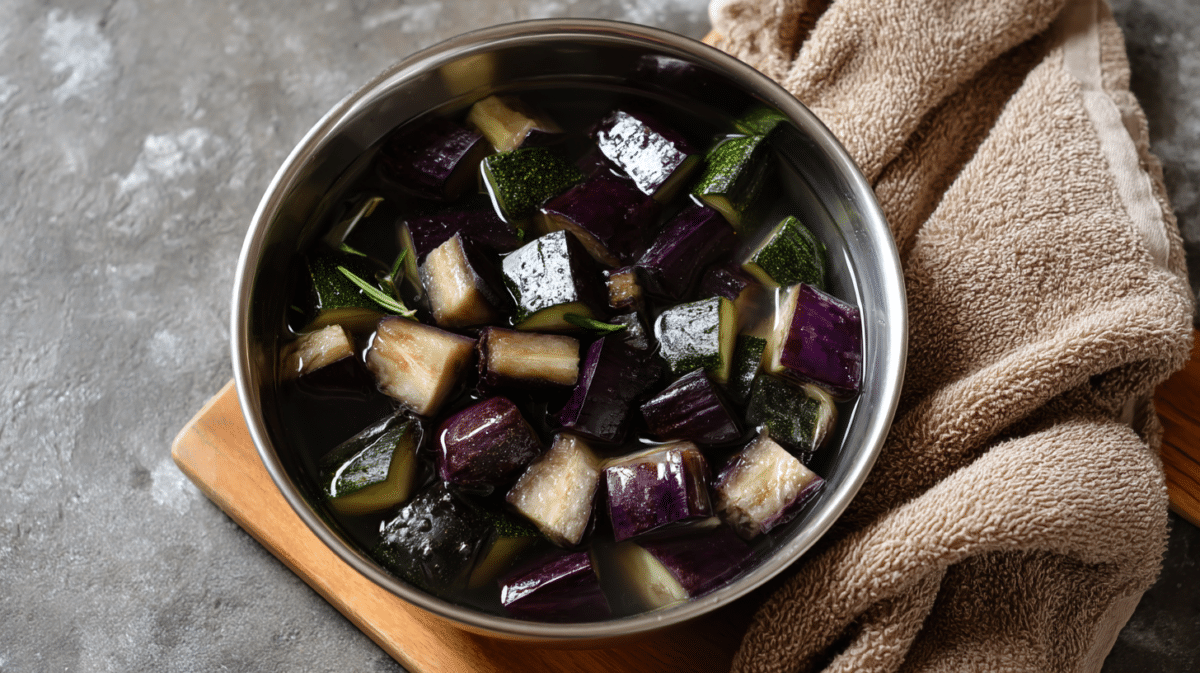
The key to making a rich and satisfying eggplant chickpea tagine is starting with well-prepared eggplant. Eggplant, by nature, has a slight bitterness and spongy texture. But with a simple prep technique, you can transform it into the velvety base of your Moroccan stew.
Start by slicing your eggplant into large, triangular chunks—roughly 1½ inches wide. Place them in a large bowl of cold water mixed with salt (about 2 teaspoons per quart of water). Use a plate to weigh them down and let soak for 20 minutes. This draws out bitterness and prevents the eggplant from absorbing too much oil during searing.
Once soaked, drain and pat the chunks dry with a clean towel. Don’t rinse them—this step ensures they hold their structure when cooked.
Salting eggplant is a traditional trick in North African dishes, especially when the vegetable plays a starring role.
Searing Tips to Retain Flavor and Texture
After prepping your eggplant, it’s time to bring out its natural richness. Heat a heavy skillet or Dutch oven with 1–2 tablespoons of olive oil over medium-high heat. Working in batches, sear each side of the eggplant chunks until golden brown—about 2 minutes per side. You’re not cooking them through here, just caramelizing the outer layers.
This step locks in flavor and gives your vegan tagine a deeply savory foundation. The golden crust also prevents the eggplant from turning mushy when simmered later in the stew.
Once seared, set the pieces aside and prepare to build the flavor base for your tagine.
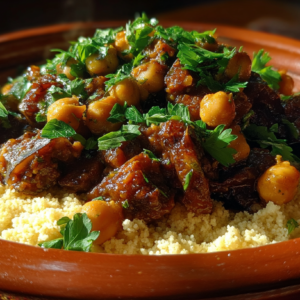
Eggplant Chickpea Tagine with Couscous: A Flavorful Moroccan Vegan Delight
Ingredients
- 1 large eggplant chopped
- 1 can chickpeas
- 1 onion 4 garlic cloves, celery, bell pepper
- 1 tbsp ras el hanout
- 1 tsp cumin ½ tsp cinnamon
- 1 can diced tomatoes
- 1 cup couscous + broth + spices for cinnamon couscous
- Olive oil salt, pepper, parsley, raisins
Instructions
- Soak and pat-dry eggplant.
- Sear until golden.
- Sauté aromatics and spices.
- Combine all ingredients.
- Bake covered at 375°F for 25–30 mins.
- Prepare couscous and serve.
Notes
PART 4: Building the Base of Flavor
The Importance of Moroccan Spices (Ras El Hanout, Cumin, Coriander)
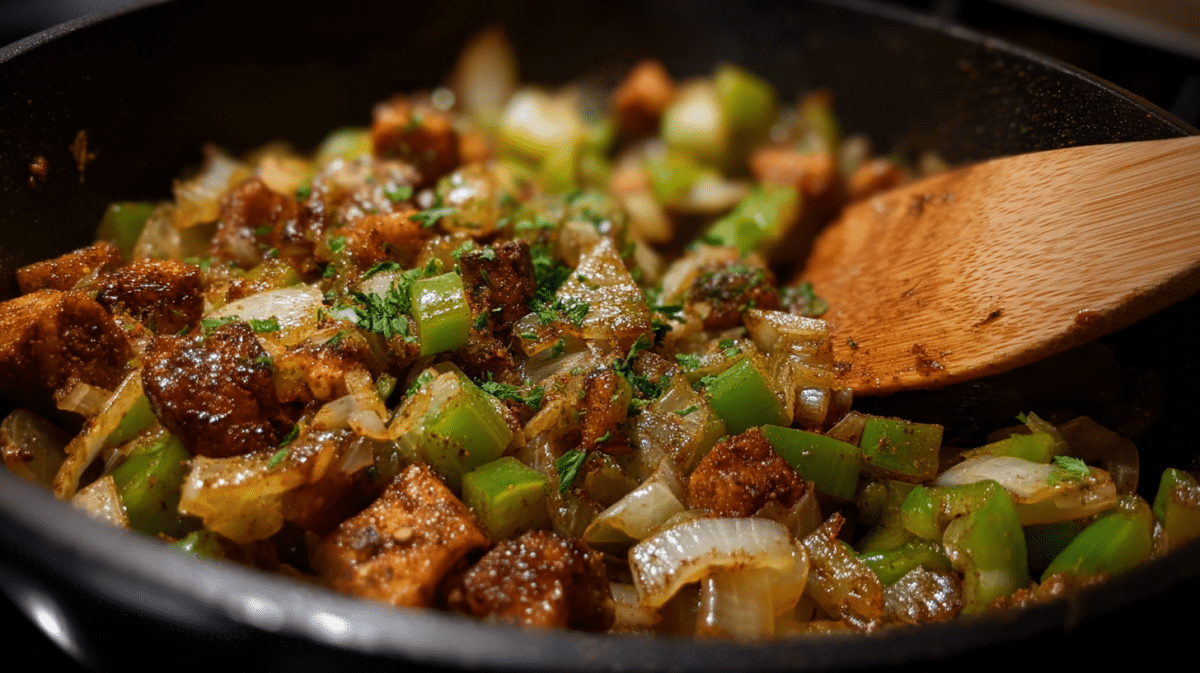
What gives a Moroccan chickpea stew its signature warmth and aroma? The spices. In this eggplant chickpea tagine with couscous, we use a vibrant blend led by Ras El Hanout—a classic Moroccan mix that can include cinnamon, cumin, ginger, clove, turmeric, and cardamom.
If you can’t find Ras El Hanout, create a quick homemade version using:
- 1 tsp cumin
- 1 tsp ground coriander
- ½ tsp cinnamon
- ½ tsp smoked paprika
- A pinch of nutmeg and cayenne
Add the spices to your sautéed vegetables and let them toast briefly before adding liquids. This step blooms the flavors, infusing your entire tagine with layered complexity.
LSI Keywords naturally included: ras el hanout, Moroccan spice blend, spiced vegetable stew.
Crafting the Aromatic Base: Onion, Garlic, Bell Pepper, Celery
Every great stew starts with aromatics. In a Dutch oven, heat another tablespoon of olive oil and add:
- 1 diced onion
- 4–6 chopped garlic cloves
- 1 diced bell pepper (red or yellow)
- 1 cup chopped celery
Sauté until softened, about 6–8 minutes. These veggies provide a sweet, earthy backbone to the tagine. The mix of onion and garlic lays down that comforting base note, while bell pepper and celery bring brightness and crunch.
Once soft, stir in the spices and let them cook for a minute to release their oils.
This flavorful vegetable mix is the true soul of your eggplant chickpea tagine and will make your couscous shine when spooned on top.
Looking for inspiration? Try Lentil Tabbouleh Salad with Herbs for a fresh complement to this hearty dish.
PART 5: Assembling and Cooking the Tagine
Layering Ingredients for Maximum Flavor
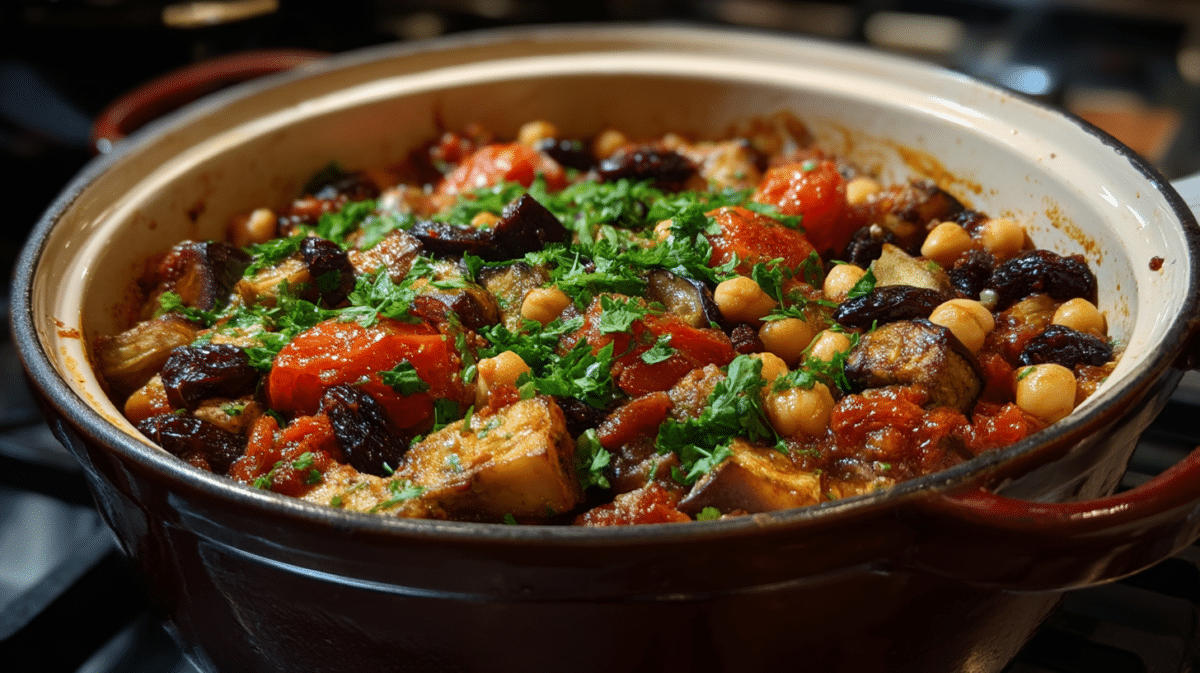
Once your vegetables are softened and your spices fragrant, it’s time to build your eggplant chickpea tagine. Add a can of crushed or diced tomatoes (14 oz) to the pot and allow them to simmer for 3–5 minutes. This gives the stew a rich, saucy base.
Next, stir in:
- 1 can of chickpeas (rinsed and drained)
- A handful of raisins or chopped dried apricots
- A splash of vegetable broth (about 1 cup)
These ingredients introduce a subtle sweetness and moisture that elevate the savory notes. Then, gently nestle in the seared eggplant pieces. Arrange them so they’re slightly submerged in the liquid, but still layered to allow even cooking.
Cover the pot with a tight-fitting lid and bake in a preheated oven at 375°F for 25–30 minutes. This slow, steady heat mimics traditional Moroccan tagine cooking methods, letting the ingredients blend harmoniously without drying out.
By the time it’s ready, the eggplant will be silky and infused with flavor, while the chickpeas retain a satisfying bite.
Oven-Baking vs Traditional Tagine Cooking: Pros & Cons
While purists may insist on using a clay tagine, most home cooks will find oven-baking in a Dutch oven just as effective—and far more accessible.
| Method | Pros | Cons |
|---|---|---|
| Clay Tagine | Authentic texture & steam circulation | Requires special equipment & care |
| Dutch Oven | Widely available, retains heat well | Lacks visual authenticity |
| Skillet + Lid | Easy for small portions | Less even temperature distribution |
This versatility means you can enjoy a rich and flavorful vegetable tagine without investing in new cookware.
PART 6: Couscous Done Right
How to Make Cinnamon-Scented Couscous
Couscous is more than a side dish—it’s the perfect companion to absorb the aromatic broth of your eggplant chickpea tagine with couscous. For the best results, infuse your couscous with spices that echo the stew’s warmth.
Here’s a quick guide:
Ingredients:
- 1¾ cup vegetable broth
- 1–2 tbsp olive oil
- 1 small cinnamon stick (or ½ tsp ground cinnamon)
- ½ tsp cumin
- ½ tsp garlic powder
- ½ tsp salt
- 1½ cups dry couscous
Instructions:
- In a pot, bring broth, oil, and spices to a boil.
- Stir in couscous, cover, and remove from heat.
- Let sit for 7–10 minutes.
- Fluff with a fork and adjust salt to taste.
This Moroccan-style couscous becomes light and fluffy, with hints of cinnamon that mirror the stew. When served together, every forkful delivers depth, contrast, and balance.
Don’t miss our guide to Tunisian vs Moroccan Couscous to learn the cultural significance and culinary distinctions of each variation.
Fluffy vs Sticky Couscous: What You Need to Know
If your couscous turns out sticky, it likely soaked up too much water or was stirred too soon. The key to perfectly fluffy couscous is:
- Use the right broth-to-grain ratio (1.75:1)
- Let it steam undisturbed
- Fluff gently with a fork, not a spoon
When done correctly, couscous acts like a sponge, soaking up every drop of that spiced tomato broth in your chickpea and eggplant stew—without clumping or turning gummy.
PART 7: Serving Suggestions & Variations
Best Garnishes: Parsley, Yogurt, Aleppo Pepper
Once your eggplant chickpea tagine with couscous is hot and ready, it’s time to add the final touches. Simple garnishes can elevate the dish from comforting to company-worthy.
Here’s what we recommend:
- Fresh flat-leaf parsley: Adds a bright, herbaceous finish
- A drizzle of olive oil: Enhances richness and sheen
- Aleppo pepper flakes: Offers gentle heat and depth
- Vegan yogurt or labneh: Creamy contrast to balance spices (optional)
These garnishes not only enhance visual appeal but also deepen the flavor experience. The spicy warmth of the stew paired with cool yogurt and soft herbs is a true taste of North African cuisine.
Looking for more fusion-style pairings? Discover great ideas like Mediterranean Crunch Salad to bring refreshing balance to this hearty meal.
Variations: Adding Apricots, Carrots, or Harissa
One of the joys of a Moroccan tagine is its adaptability. You can tailor the dish based on what’s in season or your personal taste. Here are some tasty ways to modify this vegan Moroccan dish:
| Ingredient | Effect | How to Use |
|---|---|---|
| Chopped dried apricots | Adds sweet contrast | Stir in before baking |
| Sliced carrots | Boosts heartiness | Cook with onion and garlic |
| Harissa paste | Adds smokiness and spice | Stir in with tomatoes |
This flexibility is what makes the chickpea and eggplant tagine such a favorite in plant-based kitchens.
Check out our bold recipe for Aleppo Pepper Curry if you’re craving even more spice-forward meals.
PART 8: Make-Ahead Tips and Storage
How to Enhance Flavor Overnight
This may surprise you, but the best way to enjoy this eggplant chickpea tagine with couscous might be… the next day. As the stew rests, the spices mellow and blend, the chickpeas soak up more flavor, and the overall taste deepens.
To make ahead:
- Cook the tagine fully, then let it cool
- Store in an airtight container in the fridge
- Reheat gently on the stove or in the oven
The couscous can be made fresh or stored separately. Add a splash of water or veggie broth during reheating to loosen the consistency.
This makes it an ideal healthy meal prep option for busy weeknights.
Freezing and Reheating Instructions
Need to batch-cook for later? This plant-based Moroccan stew freezes beautifully. Here’s how to freeze and reheat your tagine and couscous:
- Freezing: Cool completely. Divide into portions and place in freezer-safe containers. Label and date.
- Storage time: Up to 3 months.
- Reheating: Thaw overnight in the fridge. Reheat over low-medium heat with a splash of broth. Stir gently to avoid breaking the eggplant.
The couscous can also be frozen separately but may benefit from a quick steam or microwave reheat with olive oil to regain fluffiness.
If you’re into prepping multiple Mediterranean meals ahead of time, don’t miss our 15 Mediterranean Crockpot Recipes for more make-ahead inspirations.
PART 9: Health Benefits of Eggplant Chickpea Tagine with Couscous
Nutritional Breakdown of Key Ingredients
This eggplant chickpea tagine with couscous isn’t just packed with flavor—it’s loaded with nutrients that support a healthy, plant-forward lifestyle. Let’s break down some of the major ingredients and what they bring to the table:
| Ingredient | Nutritional Highlights | Health Benefit |
|---|---|---|
| Eggplant | High in fiber, low in calories, rich in antioxidants | Supports digestion and reduces inflammation |
| Chickpeas | Plant-based protein, iron, magnesium | Promotes muscle health, heart health, and satiety |
| Tomatoes | Lycopene, Vitamin C, potassium | Boosts immunity and heart function |
| Olive Oil | Monounsaturated fats, antioxidants | Supports brain and heart health |
| Cinnamon | Natural anti-inflammatory, stabilizes blood sugar | Balances insulin and reduces cravings |
Each spoonful delivers a satisfying combination of complex carbs, healthy fats, and vegan proteins. This makes the dish ideal for those following a Mediterranean diet, vegan meal plan, or even gluten-free lifestyle (as couscous can be substituted with millet or quinoa for gluten intolerance).
Discover our Gluten-Free Mediterranean Alternatives for additional grain substitutions.
Why This Dish is Perfect for Vegans and Gluten-Free Diets
Because this Moroccan vegetable tagine is made entirely from plant-based ingredients, it aligns beautifully with vegan diets. Chickpeas replace meat as a protein source, while eggplant provides that rich, meaty texture that many meatless recipes lack.
Additionally, if you’re avoiding gluten, simply swap the couscous with a certified gluten-free alternative like:
- Quinoa (adds extra protein)
- Millet (mild and fluffy)
- Rice (for a neutral base)
This flexibility makes it an ideal choice for entertaining or weekly meal planning when you need something crowd-pleasing and allergen-friendly.
Want more wholesome vegan ideas? Check out our guide to Mediterranean Grain Bowls that use similar ingredients in fresh and vibrant ways.
FAQ: Common Questions About Eggplant Chickpea Tagine with Couscous
Couscous and tagine are two distinct elements of North African cuisine, often served together but fundamentally different. Couscous is a tiny steamed pasta made from semolina wheat, typically light and fluffy. It serves as a base for saucy dishes.
A tagine, on the other hand, is both a slow-cooked stew and the name of the clay pot it’s traditionally prepared in. In this dish, the tagine refers to the Moroccan-style vegetable stew made with eggplant, chickpeas, tomatoes, and spices. Together, they create a complete and balanced meal.
Yes, absolutely. Chickpeas are a popular ingredient in many Moroccan tagines, especially plant-based ones. They add protein, texture, and a slightly nutty flavor that complements the soft vegetables and spiced broth. In our eggplant chickpea tagine with couscous, they serve as the primary protein source, making the dish hearty and satisfying without the need for meat.
Eggplant chickpea tagine is a Moroccan-inspired stew made with caramelized eggplant, tender chickpeas, and a rich tomato-based sauce flavored with spices like cumin, cinnamon, and ras el hanout. It’s typically slow-cooked until the vegetables are tender and served over couscous, a fluffy grain that soaks up all the delicious juices. This dish is vegan, nutritious, and full of warming North African flavors.
Yes, couscous is traditionally served with tagine. It acts as a perfect sponge for the stew’s fragrant sauce. In this recipe, we use cinnamon-scented couscous to complement the sweet and savory notes of the tagine. You spoon the tagine on top or alongside the couscous, allowing each bite to be flavorful and balanced.
Conclusion: A Moroccan Classic Reimagined for Modern Kitchens
Whether you’re living plant-based, following a Mediterranean lifestyle, or just in need of a flavorful, filling meal, Eggplant Chickpea Tagine with Couscous checks every box. This North African-inspired dish brings together bold spices, nourishing ingredients, and simple techniques into a one-pot vegan meal that feels both unfamiliar and comforting.
From the silky texture of roasted eggplant to the protein-rich chickpeas and perfectly spiced couscous, this tagine brings a harmonious balance of flavors and textures. It’s the kind of meal you’ll crave week after week—and the best part? It gets even better the next day.
This recipe is more than just a dinner—it’s a journey through Moroccan tradition with a modern plant-based twist. Make it once, and it might just become your signature dish.
Looking for inspiration? Try our Mediterranean Diet Crockpot Recipes for more flavorful, no-fuss weeknight meals.
And for even more recipes, styling tips, and pin-worthy food photography, follow us on Pinterest: Cuisinecrafted Pinterest

1 thought on “Eggplant Chickpea Tagine with Couscous: A Flavorful Moroccan Vegan Delight”